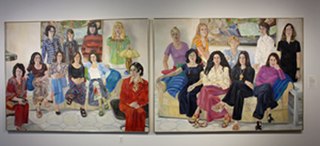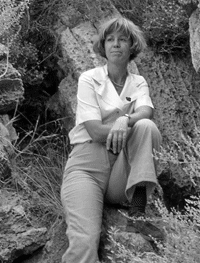Related Research Articles
Faith Wilding is a Paraguayan American multidisciplinary artist - which includes but is not limited to: watercolor, performance art, writing, crocheting, knitting, weaving, and digital art. She is also an author, educator, and activist widely known for her contribution to the progressive development of feminist art. She also fights for ecofeminism, genetics, cyberfeminism, and reproductive rights. Wilding is Professor Emerita of performance art at the School of the Art Institute of Chicago.
Horst Woldemar Janson, was a Russian Empire-born German-American professor of art history best known for his History of Art, which was first published in 1962 and has since sold more than four million copies in fifteen languages. His academic specialism was the sculpture of Donatello.
SOHO20 Artists, Inc., known as SOHO20 Gallery, was founded in 1973 by a group of women artists intent on achieving professional excellence in an industry where there was a gross lack of opportunities for women to succeed. SOHO20 was one of the first galleries in Manhattan to showcase the work of an all-woman membership and most of the members joined the organization as emerging artists. These artists were provided with exhibition opportunities that they could not find elsewhere.
Nancy Angelo is an organizational psychologist and formerly a performance and video artist who took part in the feminist art movement in Los Angeles. As an artist, she is best known for co-founding the collaborative performance art group The Feminist Art Workers in 1976 with Candace Compton, Cheri Gaulke, and Laurel Klick.

The Proposition is a genre painting of 1631 by Judith Leyster, now in the Mauritshuis in The Hague, who title it Man offering money to a young woman. It depicts a woman, sewing by candlelight, as a man leans over her, touching her right shoulder with his left hand. He is offering her coins in his right hand, but she is apparently ignoring the offer and concentrating intently upon her sewing. As we see the female protagonist (seemingly) ignore the advances of her suitor, this painting has been considered to potentially be a feminist work.
The Women's Caucus for Art (WCA), founded in 1972, is a non-profit organization based in New York City, which supports women artists, art historians, students, educators, and museum professionals. The WCA holds exhibitions and conferences to promote women artists and their works and recognizes the talents of artists through their annual Lifetime Achievement Award. Since 1975 it has been a United Nations-affiliated non-governmental organization (NGO), which has broadened its influence beyond the United States. Within the WCA are several special interest causes including the Women of Color caucus, Eco-Art Caucus, Jewish Women Artist Network, International Caucus and the Young Women's Caucus. The founding of the WCA is seen as a "great stride" in the feminist art movement.
Cynthia Carlson is an American visual artist, living and working in New York.
Lesbian Art Project was a participatory art movement founded by Terry Wolverton and Arlene Raven at the Woman's Building in Los Angeles. The pioneering project focused on giving a platform to lesbian and feminist perspectives of participants through performance, art making, salons, workshops and writing. One significant piece of work created during the project was An Oral Herstory of Lesbianism, in 1979, which documented lesbian women and their feelings, views, experiences, and expression.
Mary DuBose Garrard is an American art historian and emerita professor at American University. She is recognized as "one of the founders of feminist art theory" and is particularly known for her work on the Baroque painter Artemisia Gentileschi.
Cynthia Mailman is an American painter and educator. She is known for figurative and landscape works done in a "cool, pared-down" style. Her early paintings were presented from a perspective inside the artist's VW van, looking outward, and include mirrors, wipers or other interior elements against the exterior landscape. By doing this, Mailman put the observer in the driver's seat, which is also the artist's point of view. According to Lawrence Alloway, "The interplay of directional movement and expanding space is a convincing expansion of the space of landscape painting".
Eunice Golden is an American feminist painter from New York City, known for exploring sexuality using the male nude. Her work has been shown at the Whitney Museum of American Art, Brooklyn Museum, Bronx Museum of the Arts, Westbeth Gallery, and SOHO20 Gallery.
Women Artists in Revolution (WAR) was a New York City-based collective of American women artists and activists that formed in 1969. They seceded from the male-dominated Art Workers' Coalition (AWC), prompted by the Whitney Museum of American Art's 1969 Annual (later the Whitney Biennial), which included only eight women out of the 143 featured artists shown.
Norma Broude is an American art historian and scholar of feminism and 19th-century French and Italian painting. She is also a Professor Emerita of art history from American University. Broude, with Mary Garrard, is an early leader of the American feminist movement and both have redefined feminist art theory.

The Women's Interart Center was a New York City–based multidisciplinary arts organization conceived as an artists' collective in 1969 and formally delineated in 1970 under the auspices of Women Artists in Revolution (WAR) and Feminists in the Arts. In 1971, it found a permanent home on Manhattan's far West Side. A trailblazing women's alternative space, the Center provided exhibition and performance venues, workshops, and training courses for artists in a wide range of media for over four decades, with a focus on developing women's skills, bringing their work to the public, and fostering innovation. Prominent visual artists exhibited at the Interart Gallery, which in 1976 mounted the first ever festival of black women's film. The Interart Theatre—the Center's off-off-Broadway stage—and its productions won numerous honors. The Center hosted the Women's Video Festival for several years and ran a video program responsible for a variety of notable works.

The Conference of Women in the Visual Arts was an event held on April 20, 1972, through 22, 1972 at the Corcoran Gallery of Art in Washington DC. The conference was organized by Cynthia Bickley, Mary Beth Edelson, Barbara Frank, Enid Sanford, Susan Sollins, Josephine Withers, and Yvonne Wulff. The impetus behind the conference was anger over the complete lack of women represented at the Corcoran Biennial the previous year, 1971. The three day conference consisted of lectures and panels of women artists and art historians. It was attended by over 300 female artists, art historians, critics and museum curators.

SoHo 20 Gallery is a diptych painting by American artist Sylvia Sleigh containing portraits of the collective members of the New York art gallery SoHo 20 Gallery. It is oil on canvas with each panel measuring 72" X 96". Sleigh also created a group portrait of the A.I.R. Gallery members. The Brooklyn Rail stated that the paintings could be "read today like detailed history paintings that record the birth of the Feminist Art Movement".
Judith Kapstein Brodsky is an American artist, curator, and author known for her contributions to feminist discourse in the arts. She received her B.A. from Harvard University where she majored in Art History, and an M.F.A. from Tyler School of Art at Temple University. She is Professor Emerita in the Department of Visual Arts at Rutgers, State University of New Jersey. A printmaker herself, Brodsky is founding Director of the Rutgers Center for Innovative Print and Paper in 1996, later renamed the Brodsky Center in her honor in September 2006, and which later joined the Philadelphia Academy of Fine Arts (PAFA) in 2018. She was also co-founder, with Ferris Olin, of the Center for Women in the Arts and Humanities at Rutgers University in 2006. She was the first artist appointed as president of the Women's Caucus for Art, an active Affiliated Society of the College Art Association.

Cynthia Bickley-Green is an American painter associated with the Washington Color school. She teaches art at the School of Art and Design at East Carolina University.

Maude Boltz (1939-2017) was an American artist and co-founder of the A.I.R. Gallery.
References
- ↑ Broude, Norma; Garrard, Mary D.; Brodsky, Judith K. (1994). The power of feminist art : the American movement of the 1970s, history and impact. New York: H.N. Abrams. p. 90. ISBN 978-0810937321.
- ↑ Swartz, A. (2011). "Women Artists in Revolution". Oxford Art Online. Grove Art Online. doi:10.1093/gao/9781884446054.article.T2214396. ISBN 978-1-884446-05-4 . Retrieved 2 February 2022.
- ↑ Broude, Norma; Garrard, Mary D.; Brodsky, Judith K. (1994). The power of feminist art : the American movement of the 1970s, history and impact. New York: H.N. Abrams. p. 106. ISBN 978-0810937321.
- ↑ "Oral history interview with Jacqueline Skiles, 1971". Archives of American Art. Smithsonian Institution. Retrieved 2 February 2022.
- ↑ "Jacqueline Skiles papers, 1963-1980". Archives of American Art. Smithsonian Institution. Retrieved 2 February 2022.
- ↑ "Some Living American Women Artists/Last Supper". Smithsonian American Art Museum. Retrieved 2 February 2022.
- ↑ "Jackie Skiles". International Center of Photography. 31 January 2018. Retrieved 2 February 2022.